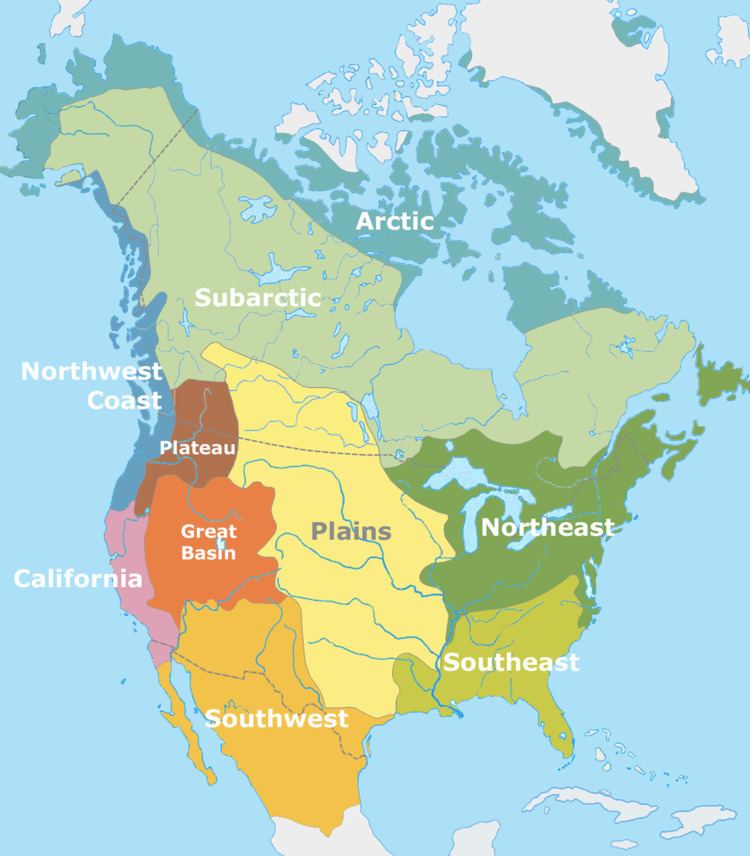 | ||
Southeastern Woodlands peoples, Southeastern cultures, or Southeast Indians are an ethnographic classification for Indigenous peoples that have traditionally inhabited the Southeastern United States and the northeastern border of Mexico, that share common cultural traits.
Contents
Cultural region
This classification is a part of the Eastern Woodlands. The concept of a southeastern cultural region was developed by anthropologists, beginning with Otis Mason and Frank Boas in 1887. The boundaries of the region are defined more by shared cultural traits than by geographic distinctions. Because the cultures gradually instead of abruptly shift into Plains, Prairie, or Northeastern Woodlands cultures, scholars do not always agree on the exact limits of the Southeastern Woodland culture region. Shawnee, Powhatan, Waco, Tawakoni, Tonkawa, Karankawa, Quapaw, and Mosopelea are usually seen as marginally southeastern and their traditional lands represent the borders of the cultural region.
Culture and history
The following section deals primarily not with the culture of the peoples in the lengthy period before European contact. Evidence of the preceding cultures have been found primarily in archeological artifacts, but also in major earthworks and the evidence of linguistics. In the Late Prehistoric time period in the Southeastern Woodlands, cultures increased agricultural production, developed ranked societies, increased their populations, trade networks, and intertribal warfare. Most Southeastern peoples (excepting some of the coastal peoples) were highly agricultural, growing crops like maize, squash, and beans for food. They supplemented their diet with hunting, fishing, and gathering wild plants and fungi.
Frank Speck identified several key cultural traits of Southeastern Woodlands peoples. Social traits included having a matrilineal kinship system, exogamous marriage between clans, and organizing into settled villages and towns. Southeastern Woodlands societies were usually divided into clans; the most common from pre-contact Hopewellian times into the present include Bear, Beaver, Bird other than a raptor, Canine (e.g. Wolf), Elk, Feline (e.g. Panther), Fox, Raccoon, and Raptor. They observe strict incest taboos, including taboos against marriage within a clan. In the past, they frequently allowed polygamy to chiefs and other men who could support multiple wives. They held puberty rites for both boys and girls.
Southeastern peoples also traditionally shared similar religious beliefs, based on animism. They used fish poison, and practiced purification ceremonies among their religious rituals, as well as the Green Corn Ceremony. Medicine people are important spiritual healers.
Many southeastern peoples engaged in mound building to create sacred or acknowledged ritual sites. Many of the religious beliefs of the Southeastern Ceremonial Complex or the Southern Cult, were also shared by the Northeastern Woodlands tribes, probably spread through the dominance of the Mississippian culture in the 10th century.
Post-European contact
During the Indian Removal era of the 1830s, most southeastern tribes were forcibly relocated to Indian Territory west of the Mississippi River by the US federal government, as European-American settlers pushed the government to acquire their lands. Some members of the tribes chose to stay in their homelands and accept state and US citizenship; others simply hid in the mountains or swamps and sought to maintain some cultural continuity. Since the late 20th century, descendants of these people have organized as tribes; in a limited number of cases, some have achieved federal recognition but more have gained state recognition through legislation at the state level.
Visual arts
Belonging in the Lithic stage, the oldest known art in the Americas is the Vero Beach bone found in present-day Florida. It is possibly a mammoth bone, etched with a profile of walking mammoth; it dates to 11,000 BCE.
The Poverty Point culture inhabited portions of the state of Louisiana from 2000–1000 BCE during the Archaic period. Many objects excavated at Poverty Point sites were made of materials that originated in distant places, indicating that the people were part of an extensive trading culture. Such items include chipped stone projectile points and tools; ground stone plummets, gorgets and vessels; and shell and stone beads. Stone tools found at Poverty Point were made from raw materials that can be traced to the relatively nearby Ouachita and Ozark mountains, as well as others from the more distant Ohio and Tennessee River valleys. Vessels were made from soapstone which came from the Appalachian foothills of Alabama and Georgia. Hand-modeled lowly fired clay objects occur in a variety of shapes including anthropomophic figurines and cooking balls.
The Calusa peoples, of southern Florida, carved and painted wood in exquisite depictions of animals.
Mississippian cultures flourished in what is now the Midwestern, Eastern, and Southeastern United States from approximately 800 CE to 1500 CE, varying regionally. After adopting maize agriculture the Mississippian culture became fully agrarian, as opposed to the preceding Woodland cultures that supplemented hunting and gathering with limited horticulture. Mississippian peoples often built platform mounds. They refined their ceramic techniques and often used ground mussel shell as a tempering agent. Many were involved with the Southeastern Ceremonial Complex, a multi-regional and multi-linguistic religious and trade network that marked the southeastern part of the Mississippian Ideological Interaction Sphere. Information about Southeastern Ceremonial Complex primary comes from archaeology and the study of the elaborate artworks left behind by its participants, including elaborate pottery, conch shell gorgets and cups, stone statuary, and Long-nosed god maskettes.
By the time of European contact the Mississippian societies were already experiencing severe social stress. Some major centers had already been abandoned.With social upsets and diseases introduced by Europeans many of the societies collapsed and ceased to practice a Mississippian lifestyle, with an exception being the Natchez people of Mississippi and Louisiana. Other tribes descended from Mississippian cultures include the Alabama, Biloxi, Caddo, Choctaw, Muscogee Creek, Tunica, and many other southeastern peoples.
